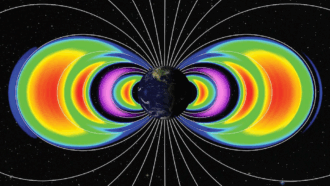atmosphere: The envelope of gases surrounding Earth, another planet or a moon.
cosmos: (adj. cosmic) A term that refers to the universe and everything within it.
fuel: Any material that will release energy during a controlled chemical or nuclear reaction. Fossil fuels (coal, natural gas and petroleum) are a common type that liberate their energy through chemical reactions that take place when heated (usually to the point of burning).
Lagrange point: A place in space where the combined gravitational forces of two larger celestial bodies — the Earth and the sun or moon, for instance — equal the centrifugal force felt by a far smaller object (such as a spacecraft or asteroid). The interaction of the forces creates a point at which some smaller body (such as a spacecraft) will appear to be "parked" in space, relative to the larger objects. The term is named for mathematican Joseph-Louis Lagrange (born in Italy as Giuseppe Lodovico Lagrangia). He wrote a paper about them in 1772. The sun-Earth system has five of these points. Any third object of relatively tiny mass that orbits at one of these points will need relatively energy to remain at this configuration relative to the two larger bodies.
orbit: The curved path of a celestial object or spacecraft around a galaxy, star, planet or moon. One complete circuit around a celestial body.
point: (in mathematics) A precise point in space that is so small that it has no size. It merely has an address.
satellite: A moon orbiting a planet or a vehicle or other manufactured object that orbits some celestial body in space.
solar: Having to do with the sun or the radiation it emits. It comes from sol, Latin for sun.
sun: The star at the center of Earth’s solar system. It is about 27,000 light-years from the center of the Milky Way galaxy. Also a term for any sunlike star.
system: A network of parts that together work to achieve some function. For instance, the blood, vessels and heart are primary components of the human body's circulatory system. Similarly, trains, platforms, tracks, roadway signals and overpasses are among the potential components of a nation's railway system. System can even be applied to the processes or ideas that are part of some method or ordered set of procedures for getting a task done.
telescope: Usually a light-collecting instrument that makes distant objects appear nearer through the use of lenses or a combination of curved mirrors and lenses. Some, however, collect radio emissions (energy from a different portion of the electromagnetic spectrum) through a network of antennas.








